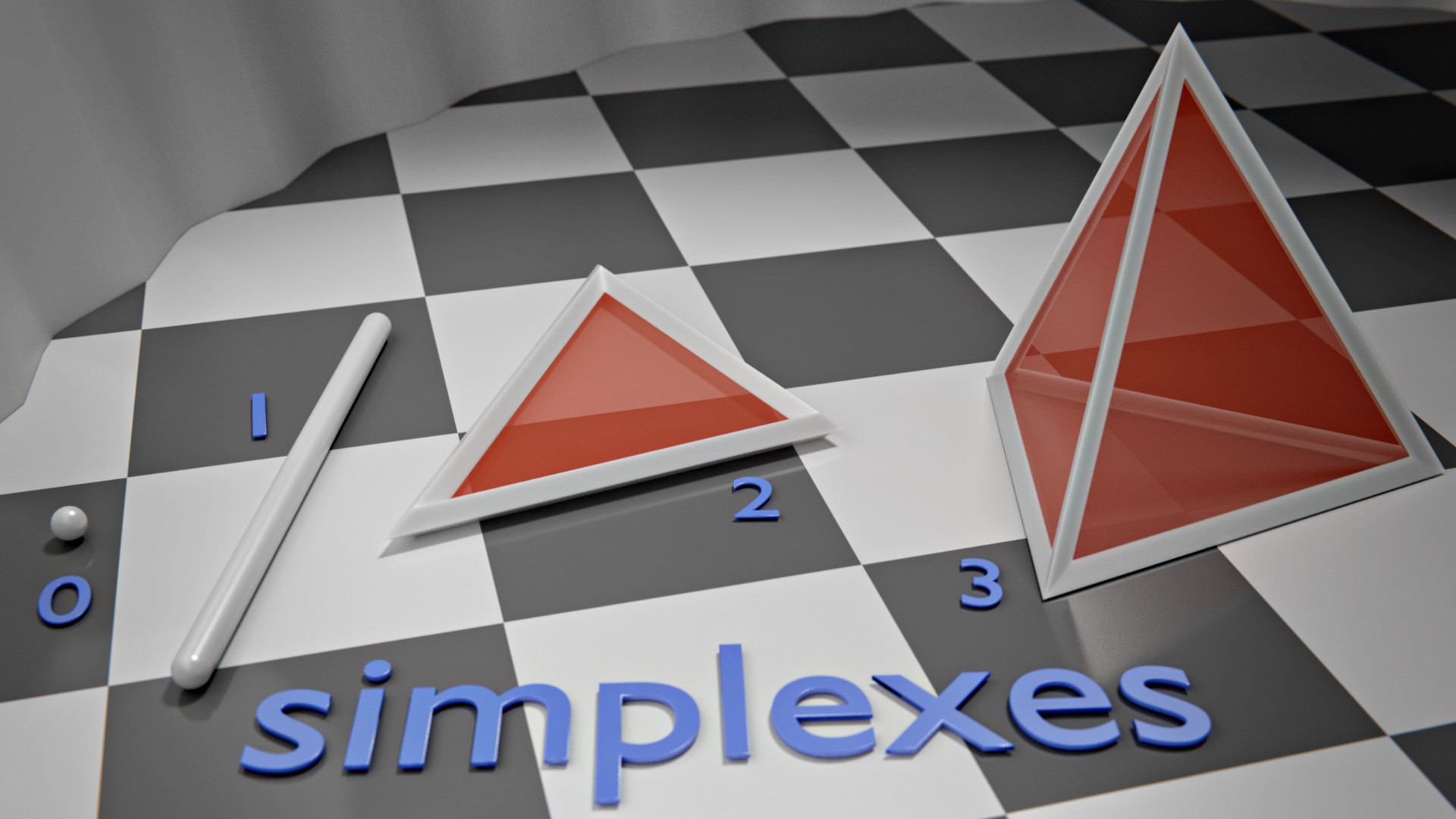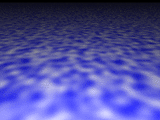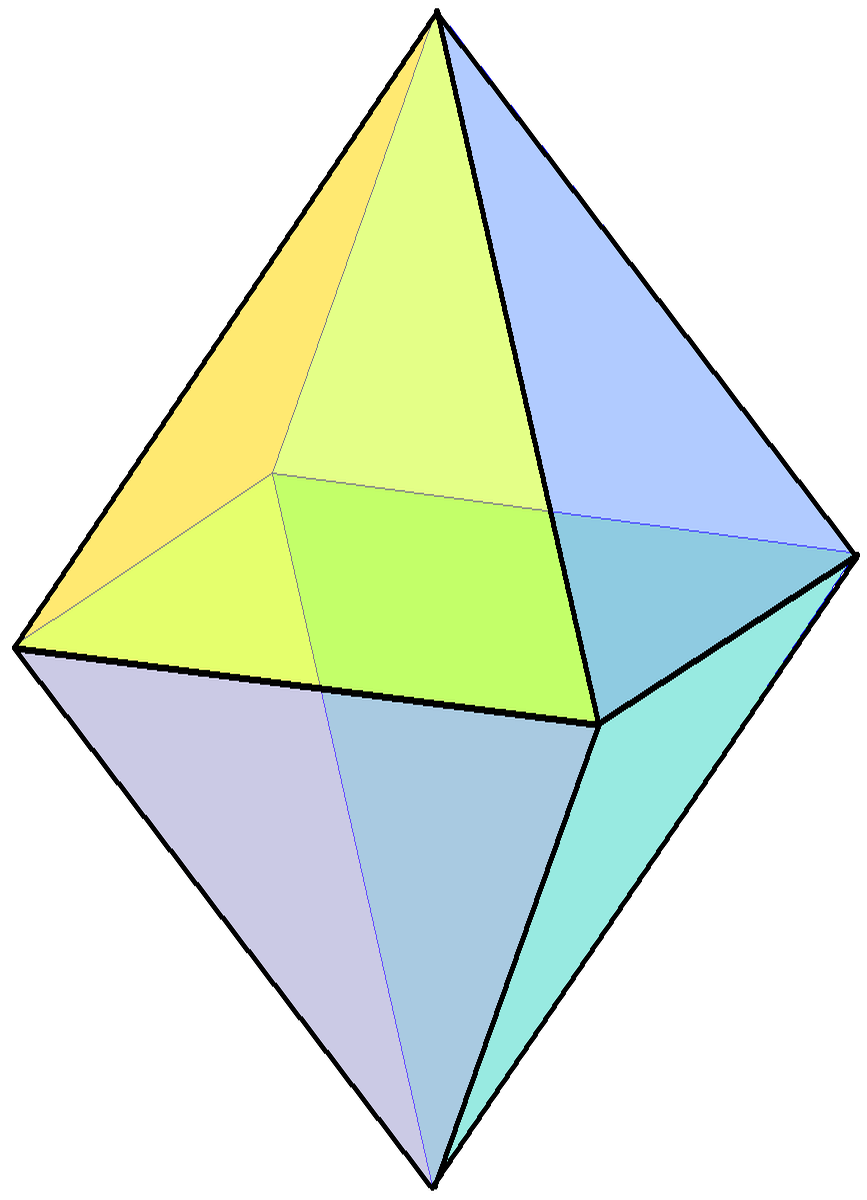|
Orthoplex
In geometry, a cross-polytope, hyperoctahedron, orthoplex, staurotope, or cocube is a regular polytope, regular, convex polytope that exists in ''n''-dimensions, dimensional Euclidean space. A 2-dimensional cross-polytope is a square, a 3-dimensional cross-polytope is a regular octahedron, and a 4-dimensional cross-polytope is a 16-cell. Its facets are simplexes of the previous dimension, while the cross-polytope's vertex figure is another cross-polytope from the previous dimension. The vertices of a cross-polytope can be chosen as the unit vectors pointing along each co-ordinate axis – i.e. all the permutations of . The cross-polytope is the convex hull of its vertices. The ''n''-dimensional cross-polytope can also be defined as the closed unit ball (or, according to some authors, its boundary) in the L1-norm, ℓ1-norm on R''n'', those points satisfying :, x_1, + , x_2, + \cdots + , x_n, \le 1. An ''n''-orthoplex can be constructed as a bipyramid#Other dimensions, bipyr ... [...More Info...] [...Related Items...] OR: [Wikipedia] [Google] [Baidu] |
Regular Polytope
In mathematics, a regular polytope is a polytope whose symmetry group acts transitive group action, transitively on its flag (geometry), flags, thus giving it the highest degree of symmetry. In particular, all its elements or -faces (for all , where is the dimension of the polytope) — cells, faces and so on — are also transitive on the symmetries of the polytope, and are themselves regular polytopes of dimension . Regular polytopes are the generalised analog in any number of dimensions of regular polygons (for example, the square (geometry), square or the regular pentagon) and regular polyhedra (for example, the cube). The strong symmetry of the regular polytopes gives them an aesthetics, aesthetic quality that interests both mathematicians and non-mathematicians. Classically, a regular polytope in dimensions may be defined as having regular Facet (geometry), facets (-faces) and regular vertex figures. These two conditions are sufficient to ensure that all faces ar ... [...More Info...] [...Related Items...] OR: [Wikipedia] [Google] [Baidu] |
5-orthoplex
In five-dimensional geometry, a 5-orthoplex, or 5- cross polytope, is a five-dimensional polytope with 10 vertices, 40 edges, 80 triangle faces, 80 tetrahedron cells, 32 5-cell 4-faces. It has two constructed forms, the first being regular with Schläfli symbol , and the second with alternately labeled (checkerboarded) facets, with Schläfli symbol or Coxeter symbol 211. It is a part of an infinite family of polytopes, called cross-polytopes or ''orthoplexes''. The dual polytope is the 5-hypercube or 5-cube. Alternate names * Pentacross, derived from combining the family name ''cross polytope'' with ''pente'' for five (dimensions) in Greek. * Triacontaditeron (or ''triacontakaiditeron'') - as a 32- facetted 5-polytope (polyteron). Acronym: tac As a configuration This configuration matrix represents the 5-orthoplex. The rows and columns correspond to vertices, edges, faces, cells and 4-faces. The diagonal numbers say how many of each element occur in the whole ... [...More Info...] [...Related Items...] OR: [Wikipedia] [Google] [Baidu] |
16-cell
In geometry, the 16-cell is the regular convex 4-polytope (four-dimensional analogue of a Platonic solid) with Schläfli symbol . It is one of the six regular convex 4-polytopes first described by the Swiss mathematician Ludwig Schläfli in the mid-19th century. It is also called C16, hexadecachoron, or hexdecahedroid.Matila Ghyka, ''The Geometry of Art and Life'' (1977), p.68 It is the 4-dimensional member of an infinite family of polytopes called cross-polytopes, ''orthoplexes'', or ''hyperoctahedrons'' which are analogous to the octahedron in three dimensions. It is Coxeter's \beta_4 polytope. The dual polytope is the tesseract (4-cube), which it can be combined with to form a compound figure. The cells of the 16-cell are dual to the 16 vertices of the tesseract. Geometry The 16-cell is the second in the sequence of 6 convex regular 4-polytopes (in order of size and complexity). Each of its 4 successor convex regular 4-polytopes can be constructed as the convex hull of a ... [...More Info...] [...Related Items...] OR: [Wikipedia] [Google] [Baidu] |
5-cube T4
In five-dimensional geometry, a 5-cube is a name for a five-dimensional hypercube with 32 vertices, 80 edges, 80 square faces, 40 cubic cells, and 10 tesseract 4-faces. It is represented by Schläfli symbol or , constructed as 3 tesseracts, , around each cubic ridge. Related polytopes It is a part of an infinite hypercube family. The dual of a 5-cube is the 5-orthoplex, of the infinite family of orthoplexes. Applying an '' alternation'' operation, deleting alternating vertices of the 5-cube, creates another uniform 5-polytope, called a 5-demicube, which is also part of an infinite family called the demihypercubes. The 5-cube can be seen as an ''order-3 tesseractic honeycomb'' on a 4-sphere. It is related to the Euclidean 4-space (order-4) tesseractic honeycomb and paracompact hyperbolic honeycomb order-5 tesseractic honeycomb. As a configuration This configuration matrix represents the 5-cube. The rows and columns correspond to vertices, edges, faces, cells, and ... [...More Info...] [...Related Items...] OR: [Wikipedia] [Google] [Baidu] |
Convex Regular 4-polytope
In mathematics, a regular 4-polytope or regular polychoron is a regular four-dimensional polytope. They are the four-dimensional analogues of the regular polyhedra in three dimensions and the regular polygons in two dimensions. There are six convex and ten star regular 4-polytopes, giving a total of sixteen. History The convex regular 4-polytopes were first described by the Swiss mathematician Ludwig Schläfli in the mid-19th century. He discovered that there are precisely six such figures. Schläfli also found four of the regular star 4-polytopes: the grand 120-cell, great stellated 120-cell, grand 600-cell, and great grand stellated 120-cell. He skipped the remaining six because he would not allow forms that failed the Euler characteristic on cells or vertex figures (for zero-hole tori: ''F'' − ''E'' + ''V'' 2). That excludes cells and vertex figures such as the great dodecahedron and small stellated dodecahedron . Edmund Hess ... [...More Info...] [...Related Items...] OR: [Wikipedia] [Google] [Baidu] |
Simplex
In geometry, a simplex (plural: simplexes or simplices) is a generalization of the notion of a triangle or tetrahedron to arbitrary dimensions. The simplex is so-named because it represents the simplest possible polytope in any given dimension. For example, * a 0-dimensional simplex is a point, * a 1-dimensional simplex is a line segment, * a 2-dimensional simplex is a triangle, * a 3-dimensional simplex is a tetrahedron, and * a 4-dimensional simplex is a 5-cell. Specifically, a -simplex is a -dimensional polytope that is the convex hull of its vertices. More formally, suppose the points u_0, \dots, u_k are affinely independent, which means that the vectors u_1 - u_0,\dots, u_k-u_0 are linearly independent. Then, the simplex determined by them is the set of points C = \left\. A regular simplex is a simplex that is also a regular polytope. A regular -simplex may be constructed from a regular -simplex by connecting a new vertex to all original vertices by the common ... [...More Info...] [...Related Items...] OR: [Wikipedia] [Google] [Baidu] |
4-polytope
In geometry, a 4-polytope (sometimes also called a polychoron, polycell, or polyhedroid) is a four-dimensional polytope. It is a connected and closed figure, composed of lower-dimensional polytopal elements: Vertex (geometry), vertices, Edge (geometry), edges, Face (geometry), faces (polygons), and Cell (mathematics), cells (Polyhedron, polyhedra). Each face is shared by exactly two cells. The 4-polytopes were discovered by the Swiss mathematician Ludwig Schläfli before 1853. The two-dimensional analogue of a 4-polytope is a polygon, and the three-dimensional analogue is a polyhedron. Topologically 4-polytopes are closely related to the Convex uniform honeycomb, uniform honeycombs, such as the cubic honeycomb, which tessellate 3-space; similarly the 3D cube is related to the infinite 2D square tiling. Convex 4-polytopes can be ''cut and unfolded'' as polyhedral net, nets in 3-space. Definition A 4-polytope is a closed Four-dimensional space, four-dimensional figure. It compr ... [...More Info...] [...Related Items...] OR: [Wikipedia] [Google] [Baidu] |
Hypercube
In geometry, a hypercube is an ''n''-dimensional analogue of a square ( ) and a cube ( ); the special case for is known as a ''tesseract''. It is a closed, compact, convex figure whose 1- skeleton consists of groups of opposite parallel line segments aligned in each of the space's dimensions, perpendicular to each other and of the same length. A unit hypercube's longest diagonal in ''n'' dimensions is equal to \sqrt. An ''n''-dimensional hypercube is more commonly referred to as an ''n''-cube or sometimes as an ''n''-dimensional cube. The term measure polytope (originally from Elte, 1912) is also used, notably in the work of H. S. M. Coxeter who also labels the hypercubes the γn polytopes. The hypercube is the special case of a hyperrectangle (also called an ''n-orthotope''). A ''unit hypercube'' is a hypercube whose side has length one unit. Often, the hypercube whose corners (or ''vertices'') are the 2''n'' points in R''n'' with each coordinate equal to 0 or 1 i ... [...More Info...] [...Related Items...] OR: [Wikipedia] [Google] [Baidu] |
Turán Graph
The Turán graph, denoted by T(n,r), is a complete multipartite graph; it is formed by partitioning a set of n vertices into r subsets, with sizes as equal as possible, and then connecting two vertices by an edge if and only if they belong to different subsets. Where q and s are the quotient and remainder of dividing n by r (so n = qr + s), the graph is of the form K_, and the number of edges is : \left(1 - \frac\right)\frac + . For r\le7, this edge count can be more succinctly stated as \left\lfloor\left(1-\frac1r\right)\frac2\right\rfloor. The graph has s subsets of size q+ 1 , and r - s subsets of size q; each vertex has degree n-q-1 or n-q. It is a regular graph if n is divisible by r (i.e. when s=0). Turán's theorem Turán graphs are named after Pál Turán, who used them to prove Turán's theorem, an important result in extremal graph theory. By the pigeonhole principle, every set of ''r'' + 1 vertices in the Turán graph includes two vertices in the same part ... [...More Info...] [...Related Items...] OR: [Wikipedia] [Google] [Baidu] |
Line Segment
In geometry, a line segment is a part of a line (mathematics), straight line that is bounded by two distinct endpoints (its extreme points), and contains every Point (geometry), point on the line that is between its endpoints. It is a special case of an ''arc (geometry), arc'', with zero curvature. The length of a line segment is given by the Euclidean distance between its endpoints. A closed line segment includes both endpoints, while an open line segment excludes both endpoints; a half-open line segment includes exactly one of the endpoints. In geometry, a line segment is often denoted using an overline (vinculum (symbol), vinculum) above the symbols for the two endpoints, such as in . Examples of line segments include the sides of a triangle or square. More generally, when both of the segment's end points are vertices of a polygon or polyhedron, the line segment is either an edge (geometry), edge (of that polygon or polyhedron) if they are adjacent vertices, or a diagonal. Wh ... [...More Info...] [...Related Items...] OR: [Wikipedia] [Google] [Baidu] |
Square (geometry)
In geometry, a square is a regular quadrilateral. It has four straight sides of equal length and four equal angles. Squares are special cases of rectangles, which have four equal angles, and of rhombuses, which have four equal sides. As with all rectangles, a square's angles are right angles (90 degrees, or /2 radians), making adjacent sides perpendicular. The area of a square is the side length multiplied by itself, and so in algebra, multiplying a number by itself is called squaring. Equal squares can tile the plane edge-to-edge in the square tiling. Square tilings are ubiquitous in tiled floors and walls, graph paper, image pixels, and game boards. Square shapes are also often seen in building floor plans, origami paper, food servings, in graphic design and heraldry, and in instant photos and fine art. The formula for the area of a square forms the basis of the calculation of area and motivates the search for methods for squaring the circle by compass and straightedge ... [...More Info...] [...Related Items...] OR: [Wikipedia] [Google] [Baidu] |
Regular Octahedron
In geometry, a regular octahedron is a Platonic solid composed of eight equilateral triangles, four of which meet at each vertex. Regular octahedra occur in nature as crystal structures. An octahedron, more generally, can be any eight-sided polyhedron; many types of irregular octahedra also exist. A regular octahedron is convex, meaning that for any two points within it, the line segment connecting them lies entirely within it. It is one of the eight convex deltahedra because all of the faces are equilateral triangles. It is a composite polyhedron made by attaching two equilateral square pyramids. Its dual polyhedron is the cube, and they have the same three-dimensional symmetry groups, the octahedral symmetry \mathrm_\mathrm . A regular octahedron is a special case of an octahedron, any eight-sided polyhedron. It is the three-dimensional case of the more general concept of a cross-polytope. As a Platonic solid The regular octahedron is one of the Platonic solids, a s ... [...More Info...] [...Related Items...] OR: [Wikipedia] [Google] [Baidu] |





